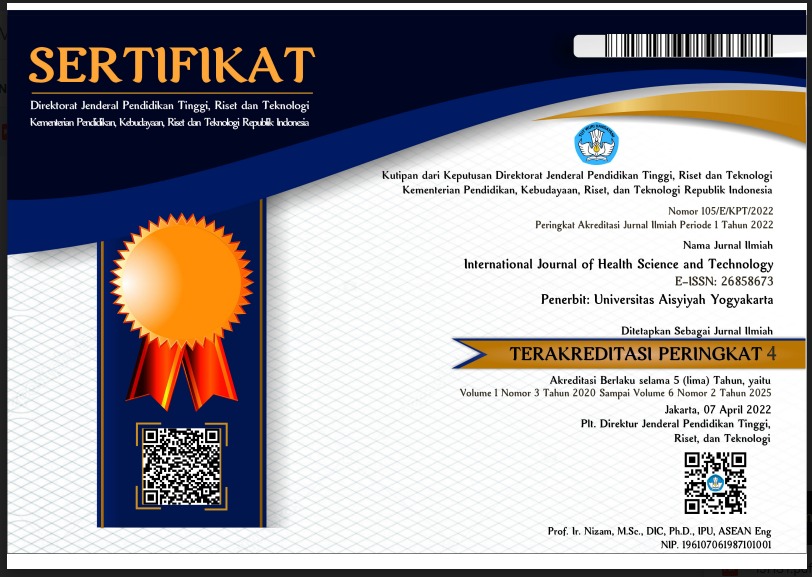The Relationship of Cadre Formation to Increasing Reproductive Health Knowledge at Miftahul Huda Tasikmalaya Islamic Boarding School
DOI:
https://doi.org/10.31101/ijhst.v5i2.2960Kata Kunci:
formation of adolescent cadres, increased knowledge, reproductive healthAbstrak
Referensi
Abrori, Hernawan, A. D. & Ermulyadi. (2017). Faktor Yang Berhubungan Dengan Kejadian Keputihan Patologis Siswi SMAN 1 Simpangan Hilir Kabupaten Kayong Utara. Unnes Journal of Public Health, 1(6), 24–34.
Adiputra, M. S., Triasnadewi, N. W., Oktaviani, N. P. W. & Munthe, S. A. (2021). Metodologi Penelitian Kesehatan (R. Watrianthos & J. Simarmata (eds.); 1st ed., Vol. 111).
Astutiningrum, D., Riyanti, E. & Ernawati. (2022). Pembentukan Kader Kesehatan Remaja dan Peningkatan Pengetahuan tentang Menstrual Hygiene dengan Edukasi Pada Santriwati. Jurnal Empati, 3(1), 29–33.
BKKBN. (2012). Pedoman Pengelolaan Pusat Informasi san Konseling Remaja dan Mahasiswa. Direktor Bina Ketahanan Remaja.
Dartiwen & Mira, A. (2022). Buku Ajar Asuhan Kebidanan Pada Remaja Dan Perimenopause (W. N. Cahyo (ed.); I). Deepublish Publisher.
Dkk, M. P. (2021). Promosi Kesehatan & Prilaku Kesehatan. In R. Watrianthos (Ed.), Jakarta: EGC. Yayasan Kita Menulis.
Halima, Raman, R. (2014). Persepsi Remaja Tentang Kesehatan Reproduksi Di Pondok Pesantren Manahilil Ulum Hidayiah Kaballangan Kabupaten Pinrang. Journal Kesehatan Masyarakat, 3(9), 41–47.
Hasan, Z. & Aryani, Y. (2020). Pembentukan Kelompok Kesehatan Reproduksi Pada Siswa MTs Muhammadiyah 02 Pekanbaru Wilayah Kerja Puskesmas Sidomulyo Kota Pekanbaru. Jurnal Ebima, 1(November), 1–7.
Hulu, V. T., Pane, H. W., Zuhriyatun, T. F., Munthe, S. A., Salman, S. H., Sulfianti, Hidayati, W., Hasnidar, Sianturi, E., Pattola & Mustar. (2020). Promosi Kesehatan Masyarakat. Yayasan Kita Menulis.
Isnawati, I. A. & Yunita, R. (2019). Konsep Pembentukan Kader Kesehatan Jiwa di Masyarakat (1st ed.). Yayasan Ahmar Cendekia Indonesia.
Kumalasari, I. & Andhyantoro, I. (2012a). Kesehatan reproduksi untuk mahasiswa kebidanan dan keperawatan. In Salemba Medika.
Kumalasari, I. & Andhyantoro, I. (2012b). Kesehatan reproduksi untuk mahasiswa kebidanan dan keperawatan. Salemba Medika.
Maryam, A. (2020). Bahan Ajar Kesehatan Reproduksi. Universitas Indonesia Timur.
Mouliza, N. (2020). Faktor yang Berhubungan dengan Kejadian Dismenore Pada Remaja Putri di MTS Negeri 3 Medan Tahun 2019. Jurnal Ilmiah Universitas Batanghari Jambi, 20(2), 545. https://doi.org/10.33087/jiubj.v20i2.912
Nasution, A., Parinduri, S. K., Asnifatima, A. & Saci, M. A. A. (2021). Peluang dan Tantangan Promosi Kesehatan Kader Kesehatan Remaja Kota Bogor. Jurnal Ilmu Kesehatan Masyarakat, 10(01), 46–54. https://doi.org/10.33221/jikm.v10i01.812
Nisa Mairo, Q. K., Rahayuningsih, S. E. & Purwara, B. H. (2015). Kesehatan Reproduksi Remaja Putri di Pondok Pesantren Sidoarjo Jawa Timur. Majalah Kedokteran Bandung, 47(2), 77–83. https://doi.org/10.15395/mkb.v47n2.457
Notoadmodjo. (2010). Metodologi Penelitian Kesehatan. Metodologi Penelitian Kesehatan, 3.
Nurasalam. (2011). Konsep Dan Penerapan Metodologi Penelitian Ilmu Keperawatan. Salemba Medika.
Nuryasinta, C. (2018). Pengaruh Penyuluh Kesehatan Reproduksi Terhadap Tingkat Tingkat Pengetahuan Dan Sikap Dalam Pencegahan Seks Pranikah di SMA Negeri Sedayu,Yogyakarta. Universitas Aisyiyah Yogyakarta.
Rahayu, A., Noor, N. S., Yulidasari, F., Rahman, F. & Putri, A. O. (2020). Kesehatan Reproduksi Remaja dan Lansia. In A. Lia (Ed.), CV Mine (1st ed.). CV Mine. https://doi.org/10.1128/AAC.03728-14
Sarwono, S. W. (2010). Psikologi Remaja (5th ed.). PT Raja Grafindo Persada.
SDKI. (2017. September). Survei Demografi dan Kesehatan Indonesia 2017 Buku Remaja. KEMENKES RI.
Sugiyono. (2015). Metode Penelitian Pendidikan Pendekatan Kuantitatif,Kualitatif,dan R&D. Alfabeta.
Sujarweni. (2016). Statistika Untuk Penelitian Kuantitatif. Graha Ilmu.
Sulistyaningsih. (2011). Metodologi Penelitian Kuantitatif dan Kualitatif. Graha Ilmu.
Swarjana I Ketut. (2022). Konsep Pengetahuan, Sikap,Perilaku,Presepsi,Setres,Kecemasan,Nyeri,DukunganSosial,Kepatuhan,Motovasi,Kepuasan,Pandemi Covid-19,Akses Layanan -Lengkap Dengan Konsep Teori,Cara Mengukur Variavel,Dan Contoh Kuesioner. (R. Indra (ed.); 1st ed., Vol. 1). CV Andi Offset.
UNICEF. (2020). Manajemen Kebersihan Menstruasi Dan Pencegahan Perkawinan Anak (H. Umniyati (ed.)). Pimpinan Pusat Muslimat NU.
WHO. (2021). Rapid Assessment Of The Implementation Of Adolenscent Health Programmes In Countries Of South-East Asia Regional Summart. In WHO. WHO.
Widyastuti, Y., Rahmawati, A. & Purnamaningrum, Y. E. (2009). Kesehatan Reproduksi. KEMENKES RI.
Winarti, E. (2017). Buku Ajar Kesehatan Reproduksi Untuk Mahasiswa Kebidanan. Indomedia Pustaka.
Wirenviona, R. & Riris, I. D. C. (2020). Edukasi Kesehatan Reproduksi Remaja. In I. Hariastuti (Ed.), Airlangga University Press (1st ed.). Airlangga University Press. https://doi.org/10.24903/jam.v4i1.776
Yovita Febriana. (2017). Efektivitas Pusat Informasi Dan Konseling Kesehatan Reproduksi Remaja (PIK-KRR) Terhadap Peningkatan Pengetahuan Remaja Tentang Kesehatan Reproduksi Remaja Di SMA Negeri 4 Kendari. Politeknik Kesehatan Kendari.
Yuliastini Fitria.,Fajriani Evaliana (2021). Pendidikan Kesehatan Reproduksi Remaja Di Pondok Pesantren Nurul Haramain Narmada. Jurnal Pengabdian Mayarakat Berkemajuan. 4(2), 47-51.
Unduhan
Diterbitkan
Cara Mengutip
Terbitan
Bagian
Citation Check
Lisensi
Hak Cipta (c) 2024 International Journal of Health Science and Technology

Artikel ini berlisensiCreative Commons Attribution-ShareAlike 4.0 International License.
International Journal of Health Science and Technology allows readers to read, download, copy, distribute, print, search, or link to its articles' full texts and allows readers to use them for any other lawful purpose. The journal allows the author(s) to hold the copyright without restrictions. Finally, the journal allows the author(s) to retain publishing rights without restrictions
- Authors are allowed to archive their submitted article in an open access repository
- Authors are allowed to archive the final published article in an open access repository with an acknowledgment of its initial publication in this journal

This work is licensed under a Creative Commons Attribution-ShareAlike 4.0 Generic License.










